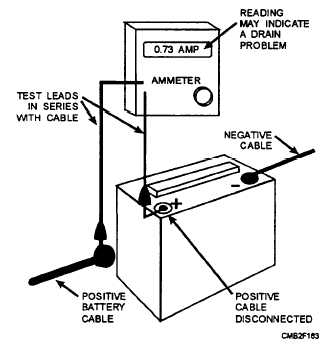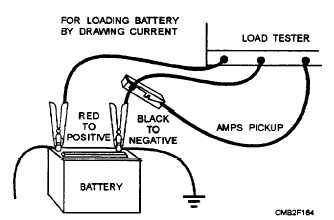
Figure 2-10. - Battery drain test setup.
rating by two. For example, a battery with 400 cold- cranking amps rating should be loaded to 200 amps (400 2 = 200). Connect the battery load tester, as shown in figure 2-11. Turn the control knob until the ammeter reads the correct load for your battery.
After checking the battery charge and finding the amp load value, you are ready to test battery output. Make sure that the tester is connected properly. Turn the load control knob until the ammeter reads the correct load for your battery. Hold the load for 15 seconds. Next, read the voltmeter while the load is

Figure 2-11. - Instrument hookup for battery capacity test.
applied. Then turn the load control completely off so the battery will not be discharged. If the voltmeter reads 9.5 volts or more at room temperature, the battery is good. If the battery reads below 9.5 volts at room temperature, battery performance is poor. This condition indicates that the battery is not producing enough current to run the starting motor properly.
Familiarize yourself with proper operating procedures for the type of tester you have available. Improper operation of electrical test equipment may result in serious damage to the test equipment or the unit being tested.
QUICK CHARGE TEST. - The quick charge test, also known as 3-minute charge test, determines if the battery is sulfated. If the results of the battery load test are poor, fast charge the battery. Charge the battery for 3 minutes at 30 to 40 amps. Test the voltage while charging. If the voltage goes ABOVE 15.5 volts, the battery plates are sulfated and the battery needs to be replaced.
GENERATORS
The generator is a machine that applies the principle of electromagnetic induction to convert mechanical energy, supplied by the engine, into electrical energy. The generator restores to the battery the energy that has been used up in cranking the engine. Whether the energy required for the rest of the electrical system is supplied directly by the generator, by the battery, or by a combination of both depends on the conditions under which the generator is operating.
The two types of generators are as follows:
The dc generator supplies electrical energy directly to the battery and or electrical system through various regulating devices.
The ac generator (alternator) has the same function as the dc generator but because only direct current can be used to charge a battery, a component, called a rectifier, must be used to convert from alternating to direct current. The ac generator (alternator) will be explained in further detail later in this chapter.
Direct-Current (dc) Generator
The dc generator (fig. 2-12) essentially consists of an armature, a field frame, field coils, and a commutator with brushes to establish electrical contact with the rotating element. The magnetic field of the generator usually is produced by the 2-11
Continue Reading